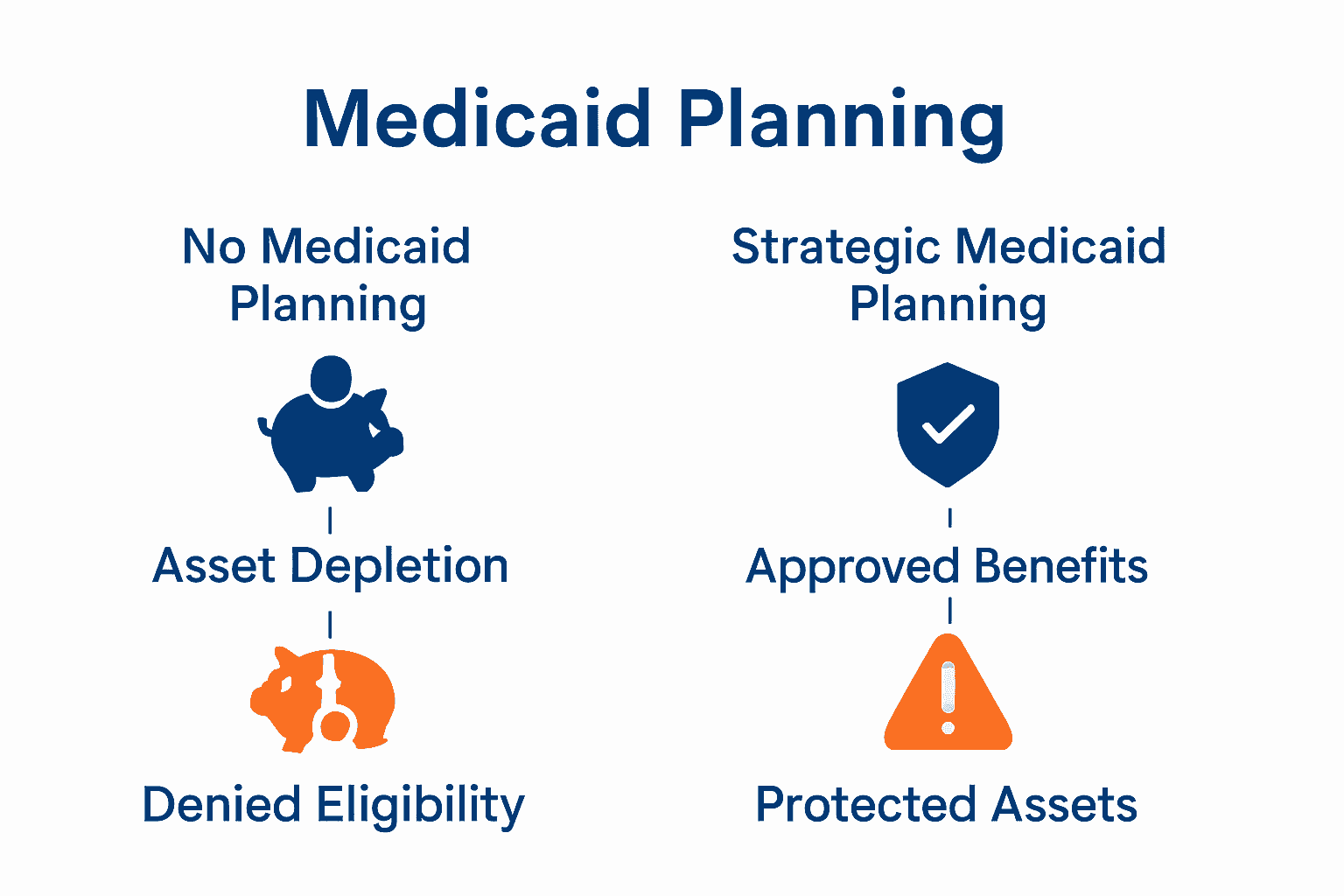
Nearly 70 percent of Americans over age 65 will need some form of long-term care, yet most families worry about losing everything to rising healthcare costs. Medicaid planning matters because it allows people to protect their life savings while securing the medical support they need. With complex rules and common mistakes that can jeopardize eligibility, learning how to approach Medicaid planning could be the key to ensuring your family’s financial future stays intact.
Key Takeaways
| Point | Details |
| Importance of Medicaid Planning | Strategic Medicaid planning helps individuals secure long-term care benefits while protecting their assets, ensuring financial stability during healthcare transitions. |
| Key Eligibility Criteria | Medicaid eligibility varies by state and includes factors such as income, residency, citizenship, and family status, necessitating careful compliance with state-specific guidelines. |
| Common Risks and Misconceptions | Misunderstandings about income limits and asset transfer rules pose significant risks, and failing to comply with state regulations can jeopardize eligibility for healthcare benefits. |
| Legal Framework | Detailed documentation of income, assets, and residency is critical in the Medicaid application process, emphasizing the need for professional legal guidance to navigate complexities effectively. |
Defining Medicaid Planning and Its Purpose
Medicaid planning represents a strategic legal approach designed to help individuals secure essential long-term care benefits while protecting their hard-earned personal assets. According to Medicaid.gov, Medicaid planning involves carefully crafted strategies that enable qualified individuals to access critical healthcare services without completely depleting their financial resources.
At its core, Medicaid planning helps middle-income families navigate complex eligibility requirements and preserve wealth during challenging healthcare transitions. The primary goal is to secure benefits for long-term care services while maintaining financial stability. This process requires sophisticated legal techniques that strategically position an individual’s assets to meet strict government guidelines.
The fundamental objectives of Medicaid planning include:
-
Qualifying for Medicaid benefits without spending down entire life savings
-
Protecting family assets from being completely consumed by healthcare expenses
-
Ensuring access to quality long-term care services
-
Maintaining financial dignity and independence for seniors
-
Preventing potential family financial hardship
Strategic Medicaid planning isn’t about avoiding responsibilities but intelligently managing resources. Medicaid Asset Protection Trusts offer one sophisticated method families can utilize to safeguard their financial future while meeting legal requirements. Professional guidance becomes crucial in developing personalized strategies that align with individual financial circumstances and long-term care needs.
Key Medicaid Eligibility Criteria and Rules
Medicaid eligibility is a complex landscape of requirements that vary significantly across different states and population groups. The government website, HHS.gov, advises that eligibility is primarily determined by three critical factors: income level, family size, and state-specific regulations. These guidelines cover diverse populations including children, pregnant women, elderly individuals, and people with disabilities.
The income standards for Medicaid are typically expressed as a percentage of the federal poverty level, creating a nuanced framework for qualification. Medicaid.gov highlights that these eligibility levels can differ dramatically between states, making professional guidance essential for navigating the application process.
Key eligibility criteria generally include:
-
Proof of residency in the state where applying
-
Income below specific thresholds
-
U.S. citizenship or qualified immigrant status
-
Age, disability, or family status meeting program requirements
-
Verification of financial resources and assets
For comprehensive guidance through this intricate process, families can consult the Medicaid Eligibility Attorney Guide, which provides detailed insights into meeting complex qualification standards. Understanding these nuanced rules requires careful analysis of individual circumstances and potential strategic planning to meet eligibility requirements.

Essential Medicaid Planning Strategies and Tools
Medicaid planning requires sophisticated strategies to protect assets while qualifying for essential healthcare benefits. Strategic asset management involves carefully planned approaches like asset transfers, establishing specialized trusts, and converting countable assets into exempt resources to meet strict eligibility requirements.
Understanding the nuanced landscape of Medicaid planning is critical for families seeking to preserve their financial stability. MACPAC emphasizes that effective planning goes beyond simple asset protection, requiring a comprehensive understanding of income and asset limits, strategic spend-down techniques, and careful navigation of state-specific regulations.
Key Medicaid planning strategies include:
-
Creating Medicaid-compliant trusts
-
Implementing strategic asset transfers
-
Converting countable assets to exempt assets
-
Utilizing spend-down techniques
-
Exploring spousal asset protection provisions
Families facing complex Medicaid planning challenges can gain valuable insights by exploring strategies for navigating the 5-year lookback period, which is crucial for understanding potential penalties and protecting family wealth. Professional legal guidance becomes essential in developing personalized strategies that align with individual financial circumstances and long-term care needs.
Legal Framework and Documentation Process
Medicaid planning operates within a complex legal landscape that requires meticulous attention to federal and state regulations. Medicaid eligibility is governed by intricate laws that mandate comprehensive documentation of an individual’s income, assets, residency, and citizenship or immigration status. This multi-layered legal framework ensures that only qualified individuals receive critical healthcare benefits.
The legal framework encompasses both federal guidelines and state-specific regulations, creating a nuanced process that demands precise documentation and careful navigation. The application process requires applicants to provide a comprehensive set of documents that demonstrate their eligibility across multiple dimensions.
Critical documentation typically includes:
-
Proof of identity (government-issued photo ID)
-
Social Security documentation
-
Proof of income (tax returns, pay stubs)
-
Residency verification
-
Citizenship or immigration status documents
-
Financial statements and asset documentation
-
Medical records and disability documentation (if applicable)
Navigating this complex documentation process can be overwhelming, which is why consulting a Medicaid Eligibility Attorney Guide becomes crucial for families seeking to understand and successfully complete the intricate legal requirements. Professional legal guidance can help streamline the process, ensuring all necessary documentation is accurately prepared and submitted.
Risks, Mistakes, and Common Misconceptions
Medicaid planning is fraught with potential pitfalls that can derail even the most carefully crafted strategies. Common misconceptions frequently lead individuals to make critical errors, particularly in overestimating income limits and misunderstanding complex asset transfer rules. These misunderstandings can quickly transform a well-intentioned plan into a potential eligibility disaster.
New York maintains unique Medicaid rules, creating a complex landscape where a misstep can result in immediate penalties or outright denial of critical healthcare benefits.
Most prevalent risks and misconceptions include:
-
Believing all assets can be freely transferred without consequences
-
Assuming income limits are uniform across all states
-
Overlooking the 5-year lookback period for asset transfers
-
Failing to understand spend-down strategies
-
Thinking Medicaid planning can be a last-minute decision
-
Underestimating the complexity of asset protection rules
To effectively navigate these challenges, families can explore strategies for avoiding 5-year lookback penalties, which provides crucial insights into protecting assets while maintaining Medicaid eligibility. Professional legal guidance becomes not just beneficial, but essential in preventing potentially costly mistakes that could jeopardize long-term care planning.

Secure Your Future with Expert Medicaid Planning Help
Facing the complexities of Medicaid planning can feel overwhelming when your goal is to protect assets and qualify for essential long-term care benefits. This article highlights key challenges like navigating strict eligibility rules, avoiding costly mistakes such as penalties from the 5-year lookback period, and using specialized tools like Medicaid-compliant trusts. If you want to preserve your family’s financial security while ensuring access to quality care, you need trusted guidance tailored to your unique situation.
At Alatsas Law Firm, we understand the emotional and financial stress middle-income families in Brooklyn face. With years of experience in Medicaid planning and asset protection, our team offers personalized strategies rooted in a thorough understanding of federal and state laws. Don’t wait until it is too late to safeguard your assets and secure your benefits. Start protecting your legacy today by exploring our Medicaid Eligibility Attorney Guide and learning how to navigate the 5-year lookback period effectively. Ready to take the next step Reach out to us now via our contact page and schedule a consultation with a dedicated legal expert who can help you develop a smart Medicaid plan designed around your needs.
Frequently Asked Questions
What is Medicaid planning?
Medicaid planning is a strategic legal approach designed to help individuals secure long-term care benefits while protecting personal assets from being depleted by healthcare costs.
What are the key eligibility criteria for Medicaid?
Key eligibility criteria typically include proof of residency, income below specific thresholds, U.S. citizenship or qualified immigrant status, and verification of financial resources and assets.
What are some common Medicaid planning strategies?
Common Medicaid planning strategies include creating Medicaid-compliant trusts, implementing strategic asset transfers, converting countable assets to exempt assets, and utilizing spend-down techniques.
How can I avoid mistakes in Medicaid planning?
To avoid mistakes in Medicaid planning, it’s crucial to understand common misconceptions, such as the rules around asset transfers and the importance of the 5-year lookback period, as well as seeking professional guidance to navigate complex regulations.

